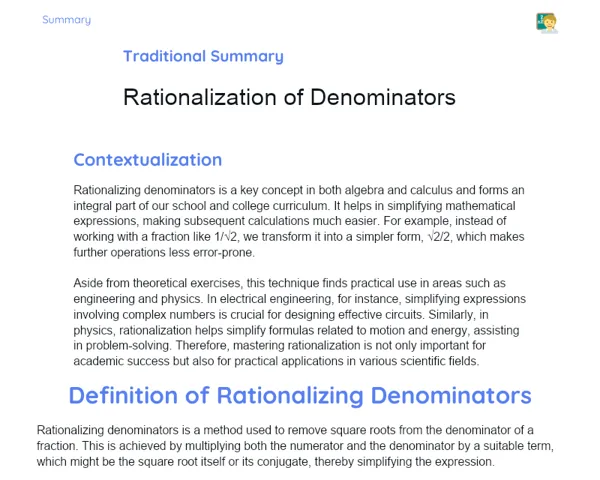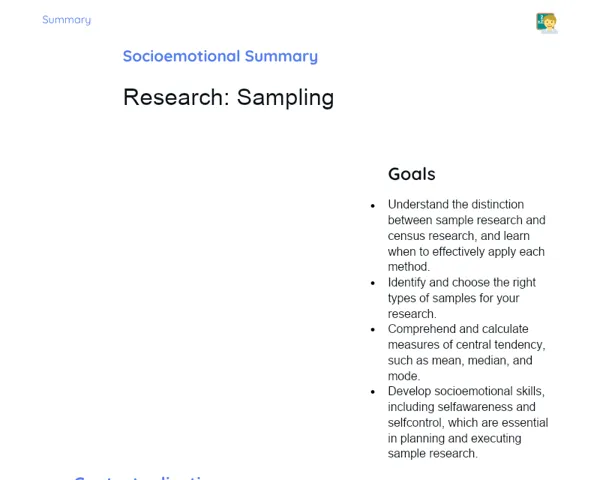Goals
1. Plot complex numbers in the complex plane.
2. Identify points in the complex plane.
3. Recognize key geometric loci in the complex plane.
Contextualization
Complex numbers go beyond real numbers, enabling solutions to equations that have no real answers. These numbers are visualized in the complex plane, which serves as an effective tool for understanding and handling them. Graphical representations make operations like addition, subtraction, multiplication, and division more intuitive. This understanding is essential in fields such as electrical engineering, physics, and computer graphics. For example, in electrical engineering, complex numbers are vital for analyzing alternating current circuits, while in computer graphics, they help produce stunning visual effects.
Subject Relevance
To Remember!
Representation of Complex Numbers in the Complex Plane
In the complex plane, complex numbers are shown as points on a two-dimensional grid. The horizontal axis (real axis) denotes the real part, while the vertical axis (imaginary axis) indicates the imaginary part. For instance, the complex number z = a + bi corresponds to the point (a, b).
-
The horizontal axis is termed the real axis.
-
The vertical axis is referred to as the imaginary axis.
-
A complex number z = a + bi is depicted by the point (a, b).
-
The distance from this point to the origin is referred to as the modulus of the complex number.
Identifying Points in the Complex Plane
Understanding the relationship between complex numbers and their graphical representations is key to identifying points in the complex plane. Students should be adept at locating specific points given a complex number, and conversely, identify complex numbers from a point's position, along with performing basic operations among these points.
-
Every point in the complex plane correlates with a unique complex number.
-
A point's position is determined by its coordinates (a, b).
-
Performing operations with complex numbers generates new points in the plane.
-
Grasping this identification is essential for solving practical issues involving complex numbers.
Geometric Loci in the Complex Plane
Geometric loci in the complex plane signify groups of points meeting specific geometric criteria. These groups can represent circles, lines, or designated regions of the plane, making it easier to visualize properties and relationships among complex numbers.
-
A geometric locus can take the form of a line, circle, or any curve.
-
Distinct geometric conditions dictate which points belong to a given geometric locus.
-
For example, a circle centered at the origin with radius r is represented by |z| = r.
-
Understanding geometric loci assists in analyzing equations involving complex numbers.
Practical Applications
-
In electrical engineering, complex numbers are used to assess and design alternating current circuits, including impedance representation and phasor analysis.
-
In computer graphics, complex numbers are instrumental in generating fractals and simulating intricate transformations, contributing to eye-catching visual effects and animations.
-
In physics, complex numbers are utilized in studying waves and wave phenomena, aiding in the analysis of wave functions and comprehending interference and diffraction.
Key Terms
-
Complex Numbers: Numbers expressed in the form a + bi, where a and b are real numbers and i signifies the imaginary unit.
-
Complex Plane: A two-dimensional coordinate system employed to depict complex numbers, consisting of the real and imaginary axes.
-
Real Part: The component a of the complex number a + bi.
-
Imaginary Part: The component b of the complex number a + bi.
-
Modulus: The distance from the point (a, b) to the origin in the complex plane, calculated as √(a² + b²).
-
Argument: The angle between the vector representing the complex number and the positive real axis, typically measured in radians.
Questions for Reflections
-
How does visualizing complex numbers in the complex plane enhance our understanding of their operations?
-
In what ways could the ability to graphically depict complex numbers benefit your future profession?
-
What hurdles did you encounter while working with complex numbers, and how did you overcome them during practical exercises?
Practical Challenge: Operations with Complex Numbers
Strengthen your grasp of complex numbers and their representation in the complex plane by performing various operations and graphing them.
Instructions
-
Select two different complex numbers, for example, 2 + 3i and -1 + 4i.
-
Plot both numbers in the complex plane using graph paper or graphing software.
-
Carry out addition and subtraction operations with these complex numbers.
-
Graphically represent the outcome of these operations in the complex plane.
-
Compare the resulting points and discuss how graphical representation aids in understanding the operations performed.



